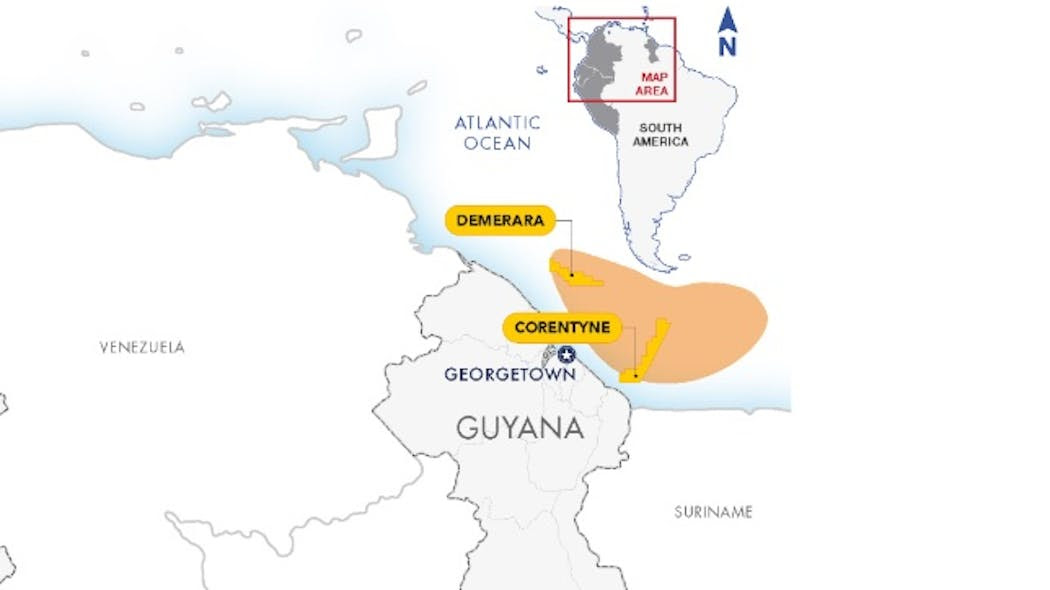ExxonMobil cleared for 35-well campaign after huge prior finds
5 July 2023 : By Fabio Palmigiani
The Environmental Protection Agency (EPA) has approved an ambitious plan submitted by US supermajor ExxonMobil to drill 35 new wells in the prolific Stabroek block.
ExxonMobil has already discovered about 11 billion barrels of oil equivalent in recoverable resources at Stabroek and the fresh programme is aimed at finding additional hydrocarbons in the petroliferous offshore basin.
Exxon consortium wins approval for 35 new wells
Guyana’s Environmental Protection Agency (EPA) granted approval for an Exxon Mobil consortium to drill 35 new offshore exploration and appraisal wells, reported Reuters.
The approval allows the consortium which includes US oil company Hess and SOC China National Offshore Oil Corporation. to drill within its 6.6-million-acre Stabroek offshore block.
The EPA said that new drilling “can be conducted in accordance with good environmental practices, and in a manner that avoids, prevents and minimises any adverse effects which could result from the activity”.
Last month, Reuters reported that the petrostate was in talks with the Exxon-led consortium to return about 20% of unexplored or undeveloped areas within the group’s blocks.
As per the 2016 production agreement, the Exxon-led consortium is required to relinquish at least 20% of unexplored or undeveloped offshore areas it owns at the renewal. The offshore areas include parts of the Stabroek block and two other blocks, Kaieteur and Canje.
However, Exxon said that it will continue with oil and gas drilling even if the area is reduced due to relinquishment. The new drilling campaign is scheduled to commence in the third quarter of this year and is expected to extend through 2028.
The project is being developed to discover new resouirces and re-evaluate existing recoverable hydrocarbons from reservoirs in the Stabroek Block, thereby enabling potential future development projects.
OGV Energy magazine
Hess- Guyana has multi-billion barrels of oil exploration potential
June 26, 20230
Guyana has been producing oil since 2019 and as of this year produced over 375,000 barrels of oil per day. According to Hess Corporation Chief Executive Officer (CEO) John Hess, multi-billion barrels of oil exploration potential remains offshore Guyana, evidently a factor in the intense interest Guyana received for the oil blocks’ auction.
During a recent JP Morgan 2023 Energy, Power & Renewables Conference, Hess discussed the two floating production, storage and offloading (FPSO) vessels – the Liza Destiny and Liza Unity, currently producing oil in the Liza 1 and 2 developments, Stabroek Block, where Hess’ partner ExxonMobil Guyana is the operator. He revealed three other developments coming on stream.
“We’ve already sanctioned five low-cost developments. These are world class developments. The first two are on production, producing in excess of 375,000 (gross) barrels of oil per day. Recently closer to 400,000 barrels of oil per day. The performance of the reservoir and the two FPSOs is excellent. We have three more developments in queue. Payara should come on in the fourth quarter. That’s 220,000 barrels per day. And then in 2025 and 2026, Yellowtail and Uaru should come on.”
Hess is performing reservoir evaluation prior to investing billions of dollars in another production ship. In the second half of 2023, they will be drilling two more prospects, Basher and Lanternfish, near their Fangtooth well, which could be tied into a potential development or their seventh ship.
“All of this is to appraise the area for the future development of the deep horizon. We want to make sure the reservoir is going to have the right performance. We’re doing drill stem tests, extended well tests, to really figure out the aerial extent, the producibility of the reservoir. We’re optimistic about the results so far. But it’s a work in progress. As we get these well results and we calibrate the seismic, we’re starting to see other deep potential on the block. So, there’s exploration potential prospectively that we’re going to be able to build upon, because of the success we’re having at Fangtooth.”
Financially, they are getting better financial returns in Guyana than the industry average. He was optimistic that by 2027, daily production could reach 1.2 million barrels.
“I think it’s important for everybody to know, these are world class economic, world class financial returns, where the breakeven is at Brent price between US$25 and US$35, to make a ten percent return. So, it’s really the best investment return in the industry. And there’s more to come. We have a line of sight to six of these developments, to produce over 1.2 million barrels of oil per day in 2027. And the potential to have 10 FPSOs to develop that discovered resource. In addition , we still have multi-billion barrels of exploration potential remaining. It’s important to know that the Government there is very supportive of investment, very supportive of business.”
In January, the United States-based Hess Corporation announced an oil discovery at the Fangtooth Southeast-1 (Fangtooth SE-1) well located approximately eight miles southeast of the original Fangtooth-1 discovery. The new discovery also came on the heels of the January 2022 oil find at the Fangtooth-1 well.
The third development in the Stabroek Block – Payara – is on track to come online by the end of 2023 with a gross production capacity of approximately 220,000 bopd; while the Yellowtail – the fourth development – is slated for 2025 with a production capacity of some 250,000 bopd. Both these development projects have been approved by the Guyana Government.
Uaru, the fifth development, is expected to come online at the end of 2026 with a gross production capacity of approximately 250,000 bopd with first oil anticipated at the end of 2026. The development plan for Uaru was submitted for Government approval in November 2022 and approval was granted in April 2023.
ExxonMobil anticipates at least six projects offshore Guyana will be online by 2027. Partners had also said that the results of the appraisal on the Fangtooth well could see the number of planned FPSOs increased to seven.
CGX update on Wei oil find
June 29, 2023
CGX Energy and Frontera Energy confirmed an oil discovery on their Corentyne Block offshore.

Courtesy Frontera Energy Corp.
Northern Corentyne Exploration
TORONTO, Canada — CGX Energy and partner Frontera Energy confirmed an oil discovery on their Corentyne Block . Drilling operations ended on the Wei-1 well 200 km offshore Georgetown and the rig should depart early next month.

Courtesy CGX Energy’s “Corentyne North August 2022” presentation
The Wei-1 well encountered 210 ft of hydrocarbon-bearing sands in the Santonian horizon. Wireline logs and core samples were taken from this interval; due to a tool failure downhole and a replacement tool being unavailable, it was not possible to obtain oil samples. Rock and fluid properties will undergo laboratory analysis to better define net pay and provide a basis for evaluation of the Santonian section.
The partners now estimated net pay from the Maastrichtian and Campanian intervals at 77 ft. Fluid samples retrieved from both suggest light crude in the Campanian and sweet medium crude in the Maastrichtian.
Over the coming months, results will be integrated into the geological and geophysical models to provide an updated view of the entire northern portion of the Corentyne Block.
This section includes the channel complexes discovered by the Kawa-1 and Wei-1 wells and a prospective central channel complex that is not yet assessed.
Wei-1 results ‘encouraging’ as total cost estimates rise again
CGX and Frontera confirmed the discovery of oil at the Wei-1 well on the Corentyne block. Drilling operations were completed without any safety incidents. The Joint Venture expects to release the rig in early July 2023.This well lies approximately 200 kilometres offshore Georgetown, approximately 14 kilometres northwest of the companies’ first discovery in this block. the Kawa-1 light oil and condensate discovery.
Wei-1 well encountered 210 feet of hydrocarbon-bearing sands in the Santonian horizon where the JV acquired wireline logs and extensive core samples . The rock and fluid properties of the Santonian will now be analysed by an independent third-party laboratory over the next two to three months to define net pay and a basis for the evaluation of this interval.
The previously announced discovery in the Maastrichtian and the Campanian intervals has been updated to 77 feet of net pay. Fluid samples retrieved from the Campanian and Maastrichtian indicated the presence of light crude in the Campanian and sweet medium crude oil in the Maastrichtian. The data acquisition programme included wireline logging, MDT fluid samples and sidewall cores throughout the various intervals.
Over the next few months, the companies plan to integrate the results into the geologic and geophysical models to form an updated view of the entire northern portion of the Corentyne block, which entails the channel complexes discovered by the Kawa-1 and Wei-1 wells, and a prospective central channel complex, which is yet to be evaluated. Frontera stated,
“The joint venture is excited by the definitive presence of oil in the Maastrichtian and Campanian and the presence of hydrocarbons in the Santonian and believes there is significant potential in the block.”
Second oil discovery in Corentyne block
June 28, 2023, by Melisa Cavcic
Two oil and gas players of Canada, CGX Energy and Frontera Energy, made a second discovery in the Corentyne block offshore, encountering 210 feet of petroliferous sands in the Santonian.
In February 2022, the partners disclosed a plan to spend up to $130 million on their second exploration well on the Corentyne block, Wei-1 with the spudding of the well in October 2022, using the semi-submersible rig Maersk Discoverer (now Noble Discoverer). In November 2022 the duo revised the spud window for the Wei-1 well after the Noble Discoverer rig was delayed on its assignment with Shell in Trinidad and Tobago. As a result, the start of drilling operations in Guyana was anticipated between December 2022 and late January 2023. In line with this, the Wei-1 well was spudded in January 2023.
Earlier, the companies revised their total Wei-1 cost estimates to approximately $190-$195 million from the previous increase to $175-$190 million to complete the logging runs, finish well operations and release the rig.

